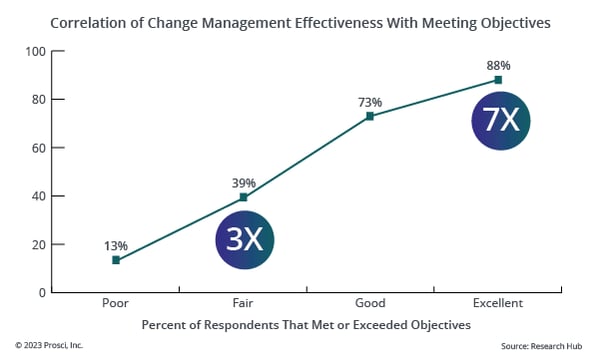Create a Business Case for Change Management

4 Mins
Updated: December 20, 2023
Published: November 17, 2021

A business case captures the reasoning for initiating a project or task and helps convince a decision maker to take action.
A well-structured, formal document, the business case tells the story of an initiative from beginning (the problem or situation that triggered the initiative) to end (the expected benefit, value or return). Business cases are typically written at the project or initiative level as a way to secure funding and commitment.
Value of the
Business Case for Change Management
The business case is a powerful vehicle for presenting the rationale and approach for change management because it helps address some of the most common objections or challenges to change management. In a webinar on the business case for change management, attendees shared the objections to change management they face most often, including:
- Lack of understanding about what it means to apply change management to a project
- Leaders and colleagues who don't see the value of change management
- The perception that change management is "soft" or "fuzzy"
- Change management differs from what they are accustomed to
Using a business case for change management directly addresses these common challenges.
Foundation of the
Business Case for Change Management
A business case captures the reasoning for initiating a project or task to convince a decision maker to take action. To build an effective business case for change management, you need to answer four key questions:
1. What is the project or task?
A business case proposes a specific project or task. Your “project or task” is to apply a structured change management approach on a particular project or initiative.
2. What is the reasoning?
A business case presents the reasoning and rationale for initiating the project or task. For the change management business case, the reasoning is that the ultimate benefit realization, value creation, and achievement of results and outcomes for the specific project or initiative are directly tied to managing the people side of change.
Get Prosci Certified
Learn to manage change on a real organizational project when you attend the
Prosci Change Management Certification Program.
3. Who are we trying to convince?
The readers or audiences of a business case are the decision makers who can ultimately take action in terms of funding and support. For the change management business case, your likely audiences are senior leaders, project leaders and project managers.
4. What is the action we need?
A business case often is used to secure a level of commitment and funding for the project or task. The actions you need are:
- A commitment to apply change management on the project or initiative
- The resources and funding to apply change management
Although the business case is a common tool when relating to projects and initiatives, few change management practitioners have taken the step of translating the rationale and approach for change management into a formal business case. In one Prosci webinar, only 22% of attendees had ever written a formal business case for change management.
Sections of the Business Case
The business case tells the complete story of the proposed project or task. Prosci's approach to a business case for change management includes eight sections:
1. Executive summary
Give a succinct and concise presentation of vital information. This section summarizes your story. For example, “We are undertaking a major project that has a significant impact to our people and how to do their work. The proposal is to apply change management on the project so that intended project results and outcomes are achieved.”
2. Situational assessment and problem statement
Directly connect the results, outcomes, value and benefits realization of the initiative to the people side of change. The situational assessment and problem statement do not directly mention change management, but instead shows dependencies.
3. Project description
Present the high-level description, scope, and objectives for the project or task. In this case, the task is applying change management. By concretely defining the task of applying change management, you give the reader confidence that you will effectively address the situation presented.
4. Solution description
Summarize your solution of applying change management and present milestones, work streams and measurements for change management. By using terms and artifacts familiar to project leaders, such as milestones and work streams, you make change management tangible and less fuzzy.
5. Cost-benefit analysis
Clearly present the costs and anticipated benefits of applying change management. The benefits section should focus on the delivery of project results and outcomes and can include both the benefits we get from applying change management and what can happen if we do not apply change management.

6. Implementation timeline
Solidify the structured approach and build credibility by mapping change management milestones to existing project milestones, such as kickoff and go-live.
7. Critical assumptions and risk assessment
Present a SWOT analysis (strengths, weaknesses, opportunities, threats) and dependencies for applying change management.
8. Conclusions and recommendations
Clearly articulate the "ask" (resources, funding, authorization, support, etc.). This builds confidence that your solution solves the presented situation.
Advantages of a
Business Case for Change Management
The business case is a powerful vehicle for presenting the rationale and approach for change management because it helps to address some of the most common objections or challenges to change management. An effective business case:
Illustrates the application of change management on a project
The project description and solution description sections of the business case for change management present, in concrete terms, what it means to apply change management on the project, including general description, scope, objectives, work streams and milestones.
Demonstrates the value of change management
The situational assessment and problem statement section of the business case for change management directly connects the results and outcomes of the project to managing the people side of change. Without even mentioning change management, this section offers a way to show how achieving project benefits depend on the ultimate adoption of the solution by impacted employees.
Clarifies the rigor of change management
Using a business case in and of itself addresses the perception of change management as soft and fuzzy. By presenting your "people side of change" approach and rationale in a formal business case, you gain credibility and show that you are a serious player in the execution of the project.
Connects change management to what leaders know and do
A business case is familiar to project leaders and senior leaders. So are elements like scope, objectives, work streams and milestones. By telling the story of change management in a familiar format, managing the people side of change looks like what they are accustomed to seeing in the project space.
"If you talk to a man in a language he understands, that goes to his head. If you talk to him in his language, that goes to his heart." —Nelson Mandela
Build Support for Change Management
in Your Organization
There are numerous ways to tell the story of change management. A business case is just one. But its formality, structure and familiarity make it a very effective tool for gaining support, commitment, authorization and funding for change management. Presenting a formal business case for change management to a project leader or senior leader can earn you the credibility you need to make a difference on the project.


